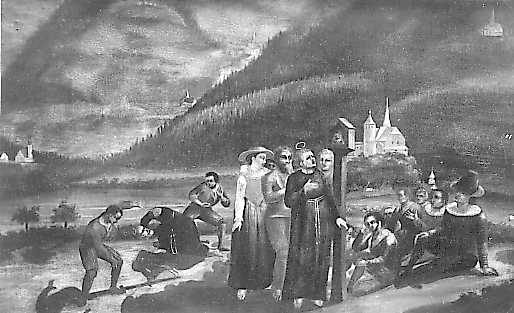

Rankweil is a well known place of pilgrimage of more than just local importance. Our Lady´s church is situated on top of a small hill at the eastern margin of the alluvial plane of the Rhine. It shows several features of a former castle, such as a parapet above the steep southern and western flanks of the hill, or a small yard in front of the church protected by a strong wall (now used as a cemetery). A legend reports that the castle had been destroyed in times of great peril. The inhabitants of the village vowed to errect a church in honour of Our Lady in case of rescue. Soon afterwards they started to build the church down at the valley´s floor. But each night the day´s work was destroyed. All vigilance was in vain. At last one night one of the workers dreamt that the Virgin Mary herself took the newly built walls and carried them up the hill. Thus the people realized that it was Her will to convert the former castle into a place of Christian worship. The church is a must to see for anyone interested in Christian magic! Two show-cases contain votives donated by pilgrims after successful healing. As they are representations of the affected limbs you will recognize mainly arm and legs, but also eyes and hearts and even babies punched out of (silver) sheets.
The arcades bordering the former courtyard host two painted panels telling the stories of local saints:
One of these legends reports a miracle connected to the death of St. Eusebius, a monk of the monastery Sankt Gallen (Switzerland). He worshiped at the hospice Viktorsberg. After being beheaded with a scythe on January 31st 884 down in the valley well within the village limits of Rankweil (the panel gives no account on the exact circumstances), Eusebius took his head and carried it up the mountain back to the hospice.
 |
Reproduction of the panel showing the death of St. Eusebius. At the right you find Our Lady´s
church. Viktorsberg is marked by the rather small building in the center of the picture.
|
St. Fridolinus was an Irish monk who missioned parts of southern Germany and Graubünden (Switzerland). Amongst the new converts were two nobleman from the town Glarus, the brothers Ursus and Landolph. Ursus afterward led a godly life and bequeathed all his wealth to the monastery of Seckingen founded by St. Fridolin. But after his death the avaricious Landolph laid hand on the legacy. The monk applied to the royal district court at Rankweil. But the judge, who was corrupted by Landolph, demanded an irrefutable proof. So Fridolinus went to Glarus, summoned Ursus - who had died two years before - out of his grave and led him by the hand all the way back to Rankweil (which is a distance of approximately 75 kilometers!). There the corpse started to speek and accused his brother of his evil deed. Landolph was so astonished by this token of the powers of the Lord, that he not only handed out the legacy but also donated his own wealth to the monastery. Fridolinus afterwards led Ursus back to his grave at Glarus. According to the panel this miracle happened 1500 years ago in 498 AD.